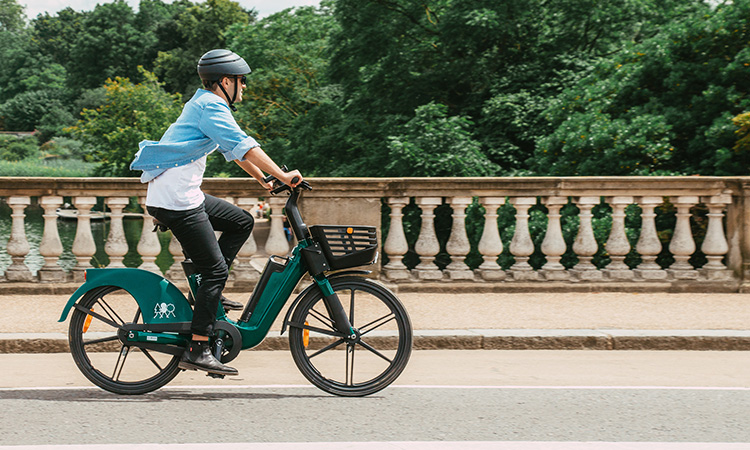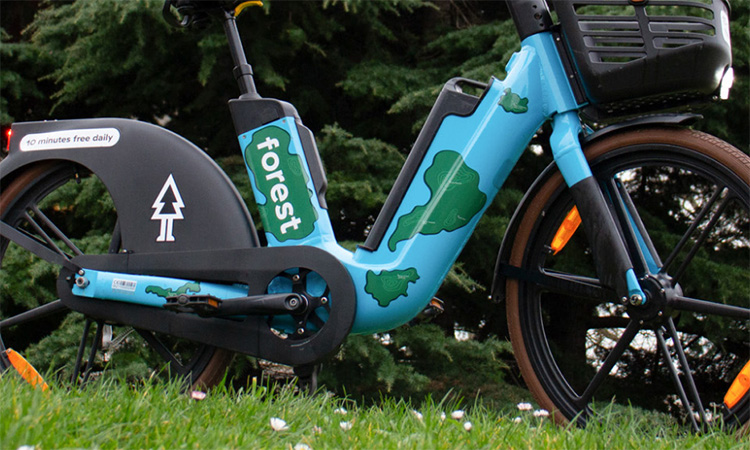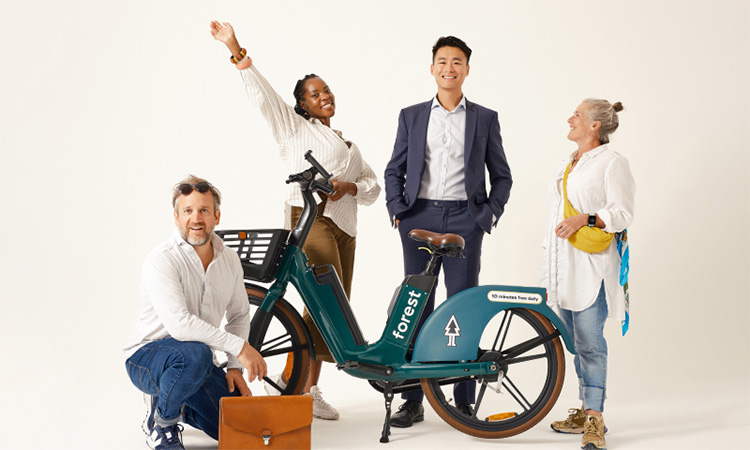Sustainability redefined: Forest’s holistic vision for environmental, employee and community wellbeing
- Like
- Digg
- Del
- Tumblr
- VKontakte
- Buffer
- Love This
- Odnoklassniki
- Meneame
- Blogger
- Amazon
- Yahoo Mail
- Gmail
- AOL
- Newsvine
- HackerNews
- Evernote
- MySpace
- Mail.ru
- Viadeo
- Line
- Comments
- Yummly
- SMS
- Viber
- Telegram
- Subscribe
- Skype
- Facebook Messenger
- Kakao
- LiveJournal
- Yammer
- Edgar
- Fintel
- Mix
- Instapaper
- Copy Link
Posted: 7 May 2024 | Laura Elms - Forest | No comments yet
Laura Elms, Head of Sustainability & Communications at Forest, spoke with Intelligent Transport’s Halimah Haque about the intricacies of Forest’s pioneering sustainability initiatives, covering topics such as leveraging pre-owned e-bikes and fostering community engagement to showcase Forest’s multifaceted approach to environmental responsibility.


Credit: Forest
Could you provide an overview of Forest’s latest sustainability report, highlighting key achievements and challenges encountered during the reporting period, and how these findings are shaping the company’s future sustainability strategy?
To give a broad overview, Forest’s latest sustainability report covers the period September 2022 to September 2023 and it looks at three pillars. That’s our relationship with the planet, the people in our company, and then the communities more broadly that we work with. We see sustainability quite holistically, within the planet side, which really forms the majority of the report. We calculate our scope 1, scope 2, and our scope 3 emissions. Then, we also give background, on those other pillars, the planet and also the communities we work with, and how we’re trying to build sustainable strategies around them. The intent of the report really is to reassure our users, the communities we operate within, investors and any other stakeholders that, whilst we’re not perfect as a company, we are really sector leading in sustainability.
The intent of the report really is to reassure our users, the communities we operate within, investors and any other stakeholders that, whilst we’re not perfect as a company, we are really sector leading in sustainability”
One of the key findings of the report was that we had 2.2 kilotons of CO2 emissions during the period as a total number. Some of the achievements was the level of offsetting we achieve. So, typically, companies will offset a portion of their scope 1, scope 2, scope 3 emissions. We cover all of it, less the portion of our bikes that we bought second-hand. The partnerships that we’ve built through the course of the year is another huge achievement.
One challenge is that, inevitably, we’re a young company and, as we grow, we have more emissions. So, how do we convey that story of growth with intelligent approaches we’ve taken to reduce emissions as we grow? That’s where, again, one of our partnerships with a carbon accounting platform, Greenly, came in to advise us and create really robust methodologies for it.
Forest has made significant strides in reducing emissions through initiatives such as the Refurbishment Project and the use of pre-owned e-bikes. What are some of the challenges and successes that have been encountered during these projects, and how do they align with the company’s long-term sustainability goals?
The purchase of pre-owned e-bikes was a big one for us because it’s not something that’s typically done in this sector. We had to ensure that, whilst those bikes were pre-owned and therefore, we were reducing emissions associated with the manufacture of the e-bikes, that we didn’t compromise on anything, for example, safety. So, they had to be pre-owned but unused, and go through our same stringent safety testing. They were also a different colour to our fleet. So the decision was, how costly and how environmentally friendly is it for us to strip these bikes back and put them on the roads as part of our Forest Green brand? Or can we think creatively around it? Which is what we ended up doing.
This aligns with our long-term goals of finding creative and intelligent ways to reduce emissions as part of our growth strategy. Both the Rivers Trust partnership for pre-owned bikes and the refurbishment project exemplify innovative thinking in our processes followed by decisive action.
That actually spurred on a really interesting project, one of our key successes, which was our pop-up with The Rivers Trust. We put these blue bikes out, which were clearly different from our Forest Green bikes. But we decided to call them the River Bike, and to team up with The River’s Trust. For every ride taken on a River Bike, 5% of the proceeds went to the charity for the duration of that partnership, which has resulted in over £30,000 going to The Rivers Trust. So we made a real success out of one of the challenges.
Another one of the challenges was with the refurbishment project. Now, that involved a lot of our operations team, who are always stretched. So, finding the capacity and a resource for them to dedicate time to thinking about improving the longevity of the bikes was a challenge. But once we found the right people for the job, specifically come to mind two of our team, Akshay, who’s an engineer, and Victor, who’s both an engineer and a data scientist, we were ready to go. That was a real success because we increased the repair rate from 60% to 71%. Excitingly, the team still think there’s a huge amount of room for improvement because it’s very much an ongoing iterative process.
This aligns with our long-term goals of finding creative and intelligent ways to reduce emissions as part of our growth strategy. Both the Rivers Trust partnership for pre-owned bikes and the refurbishment project exemplify innovative thinking in our processes followed by decisive action.
How does Forest ensure that its offsetting efforts, through partnerships like The Great Reserve, are effective and aligned with its mission of promoting sustainability?
It’s referenced on our new e-bike design, which proudly states, “We’re building a forest here”
Recently, offsetting has become really scrutinised and criticised in some respects. Often, companies can use offsetting as a way of avoiding reduction, which is really not the point. The actual efficiency of those projects has also come under scrutiny. What we decided in 2024, which differed from the previous year, was to focus on a project that was close to home. We wanted to find something UK-based, something we could visit and something that felt very tangible. And that’s when we heard about The Great Reserve. The Great Reserve is on a mission to protect and preserve the giant sequoia tree, which is now endangered in North America. It brings young sequoia saplings to the UK and builds plantations, working with both individuals and companies who are looking to offset either their personal or their corporate emissions with the planting of UK-based groves of sequoia trees. So, we work closely with them.
When it comes to your question on alignment, it was a really natural alignment. Not just because it was, as I said, UK-based, nature based, something we have gone to visit and really been hands-on, literally, with. Moreover, it aligned perfectly with our Forest Green brand ethos. In fact, it’s referenced on our new e-bike design, which proudly states, ‘We’re building a forest here.’


Credit: Forest
As you’ve mentioned, health and safety, both physical and mental, are really critical aspects of sustainability in the workplace. Can you share more about Forest’s approach to ensuring the wellbeing of its employees, including initiatives such as mental health policies?
We have very much broadened sustainability, as a concept, out from environmentalism. When I first wrote our inaugural report, in 2023, I went back and forth on whether it should be focussed on the environment or broaden it out to those other pillars. I’m really glad that I decided to make it more holistic and have those pillars where we think about health and safety, physical, mental health and our staff, more broadly. It taps into that actual notion of what is sustainability. Also, on a more practical level, it gives us, as Forest, an opportunity to check ourselves in a publicly available way.
We need to build a long-term relationship which has deep foundations with our staff. For us, that’s a lot to do with giving people the tools to support themselves”
Sustainability, is very different from environmentalism. It literally means longevity. And I think it’s widely accepted now in corporate culture that we can’t just push, push, push employees, focus on eking all we can out of them in exchange for a pay check. We need to build a long-term relationship which has deep foundations with our staff. For us, that’s a lot to do with giving people the tools to support themselves, and maintain their own personal health, both body and mind. In my opinion, it shouldn’t really be the case that when people need care the most, they have to be going through loopholes, justifying themselves, authorisation codes.
We decided, this year, to move from our traditional healthcare provider, that wasn’t really suited to a start-up world and had a lot of process associated with it, to a much more simple one, a start-up called Mo.health. They take a lot of the process out of trying to access care and make it super simple, but they also have great benefits. They provide free mental health sessions, six a year. And, anecdotally, I know that a large number of the team have used those services. What it means is, firstly, when people really need help, it’s there and it’s easy. But secondly, it also empowers people to focus more on proactive and preventative healthcare, which is a step in the right direction. If we come back to that notion of human longevity and human sustainability and, therefore, sustainability of the company more broadly, it tends to have much better outcomes.
Another aspect of sustainability that you mentioned was diversity and inclusion. So, how does Forest promote diversity and inclusion within its workforce, both in terms of recruitment practices and internal initiatives, like the Women of the Forest group?
We haven’t got a problem with diversity in the office. So, for us, it’s more how do we ensure we don’t lose that as we grow?”
We use hiring tools which remove bias as much as possible from the recruitment process. We also use surveys to have regular cadence of that feedback loop on how people feel we’re doing. In my opinion, we haven’t got a problem with diversity in the office. So, for us, it’s more how do we ensure we don’t lose that as we grow? It comes back to that same story that I’m telling around growth and ensuring that we keep true to that sustainability message.
When we asked the teams, “Do you want more DEI groups?” There wasn’t a huge amount of appetite, which is interesting. You could read into that in many different ways. But my belief, at the moment, is that we are small enough that people still feel like their voice is heard, quite naturally. They also feel like they know their people, so they know who they can go to talk about certain things, without needing to create more special spaces for them.
I guess the next question is, as we grow, either in terms of numbers of staff or as we grow geographically and so there’s a physical distance between people, how do we make sure those voices are still heard? Again, it comes back to that idea of creating sustainable conversations. But we’ll keep asking. I’d never want to overinflate what we’re doing, but I think we do enough that our people don’t feel like they need more, which is nice, because it’s organic and real.
Forest’s goals for the future encompass a wide range of sustainability initiatives, from limiting asset emissions to strengthening community engagement. What challenges do you anticipate in achieving these goals and what strategies will the company employ to overcome them?
I think it comes back to that growth story, how do we keep growing? Whether that be with regard to our impact on the planet, our staff, all the communities that we work with, whilst keeping that authenticity and commitment to these creative measures. And I think a lot of that needs to be hearing from people. We conduct numerous user surveys to understand whether our sustainability story is resonating with you. Do you hear it? Or do you not see it? Also, around affordability, so that’s another part of the sustainability strategy. We fundamentally believe that if you make the service more affordable, more people are going to get on bikes. The more people that get on bikes, the less emissions from cars, it’s simple. So how do we tap into our user base and hear from them, our staff? Here, we just talked about where they’re sitting with things like our recruitment process, our diversity initiatives and, also, communities.
That’s a big one because we are in quite a relatively young space. The micro-mobility industry has been around for a very long time, but not in the form that it is now. So, how do we hear from all the different communities we have touch points with, in London or in any other city that we choose to operate in? How do we make sure that we integrate those voices, and it informs our strategy, rather than sitting in a room, void of anyone else, and very much fall into the traps of groupthink. That’s the way, we have to orientate ourselves to stay on track.


Credit: Forest
As Forest continues to grow and evolve, what emerging trends or technologies do you foresee shaping the future of sustainable micro-mobility?
As we get to that second-generation phase, there will be an opportunity for the technology to reach a level of maturity where we don’t have to keep depending on international supply chains”
We’ve reached what we like to call the second generation of micro-mobility. We had the first generation in, say, 2016, when we saw the Mobike and Ofo on the roads, but it really has matured since then. I’d say we’re now getting to a space where there are very tight margins, and a lot of operators are struggling to reach profitability. But although that can be perceived as a tricky side of today’s market, the upside is it is leading to what we like to refer to as the second generation of operators, who are really focusing on keeping costs down, not growing too fast, focusing on financial stability, and sustainability, as we said, in all different areas.
I think something that’s really interesting as a trend is, as we get to that second-generation phase, there will be an opportunity for the technology to reach a level of maturity where we don’t have to keep depending on international supply chains for the manufacturer of the physical assets, the e-bikes. E-bikes are now reaching a stage where we don’t have such a steep trajectory of evolution. Hopefully this will ease pressure on companies, operators like ourselves, who are purchasing assets, to not always be looking to purchase new ones or to be able to do our own. And this comes back to our research and development teams, to be able to do our own analysis of an e-bike and find spare parts ourselves, so again, not be depending on that supply chain.
In turn, this will reduce costs because we won’t be spending so much on the manufacturer of the bikes. We’ll be able to focus in-house a bit more. But, also, inevitably, lowering that carbon footprint, and speeding up the process of getting the bikes fixed or onto the roads. There’ll be less expense involved and it will become a lower margin industry, with a few very sustainable players within it. That’s my hope in terms of trends in the space and it’s one to watch over the next few years.
Finally, looking ahead, how does Forest envision its role in driving broader systemic changes towards sustainability within the transportation sector and beyond?
What this whole report is about is trying to be open, transparent, honest and authentic. We’re not trying to hide anything from peers”
I really like this question because what this whole report is about is trying to be open, transparent, honest and authentic. We’re not trying to hide anything from peers. In fact, it would be fantastic if all operators had, like us, very negligible scope 1, scope 2 emissions and were just able to focus on scope 3, which is where we’re at. So, we have a tiny one tonne of scope 2 emissions, which is from fugitive emissions linked to our air conditioning in our offices. Otherwise, we’re completely scope 1 and scope 2 free. If our peers look at that and they’re able to copy us, I’m very happy.
What we’re trying to do is share that information, because for us, sustainability, particularly around environmentalism, is still relatively new. We’d love to collaborate, or maybe work with city authorities to mandate that all operators should have zero emissions vehicles that service their fleet. So, there’s no chance that you have a petrol or a diesel engine going to swap a battery on the roads. It would be really wonderful if we could all, as operators, push the manufacturers to consider battery technology that is both fire resistant, theft proof and easy to recycle, which at the moment is a genuine challenge in the space. We envision our role as, hopefully, a leader that is very willing to share information and drive really positive change for the whole space.


Related topics
Micro-mobility, Sustainable Urban Transport, Workforce Inclusivity, Workplace
Related modes
Bikes & Scooters
Related cities
London
Related countries
United Kingdom
Related organisations
Forest, HumanForest
Related people
Laura Elms








